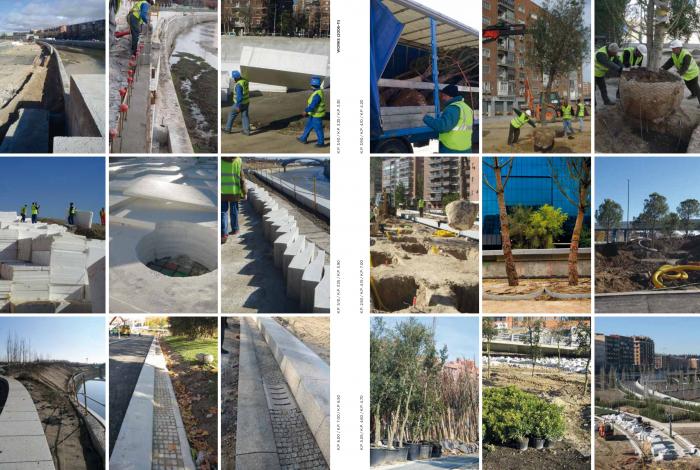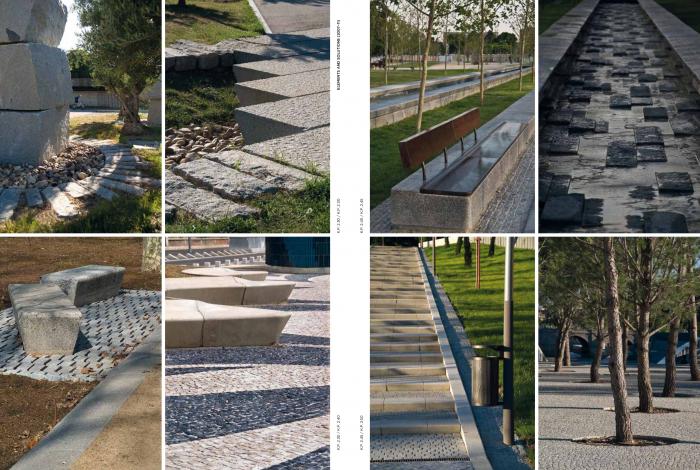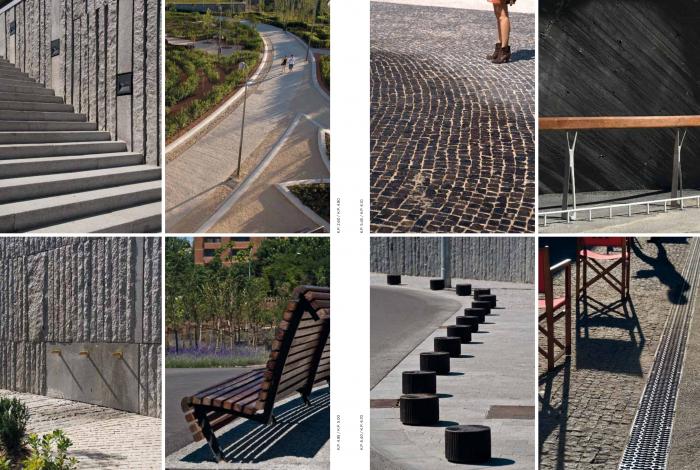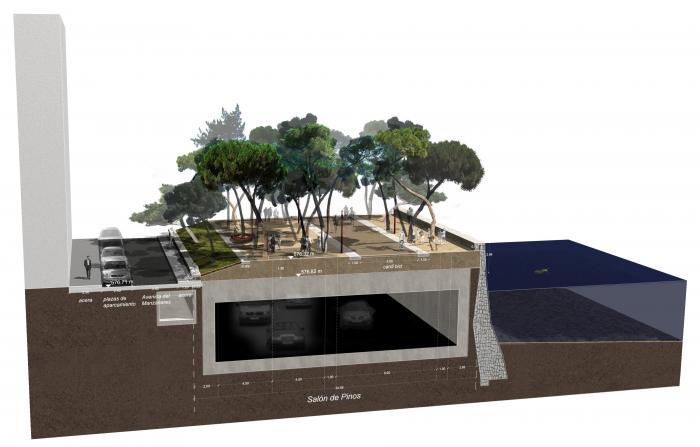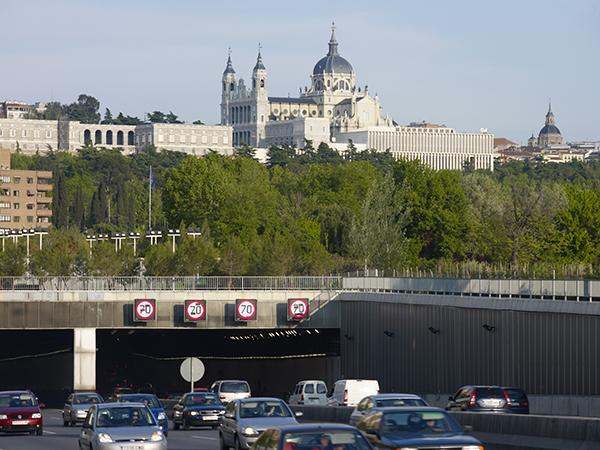I. SUMMARY INFORMATION
Project
269136
Status
Submitted
Award category
Techniques, materials and processes for construction and design
You want to submit
NEW EUROPEAN BAUHAUS AWARDS : existing completed examples
Project title
Madrid Río
Full project title
Madrid Río. A project of Urban Transformation
Description
Madrid Río is a truly exceptional project. Undoubtedly, it is the most important project executed in Madrid over the last few decades and probably one of the most ambitious projects carried out in Europe in recent times. It is only comparable to the Big Dig, completed in Boston, USA. This is perhaps the first european project that truly integrates large infrastructure and the built urban fabric with the natural environment that surround them.
Where was your project implemented in the EU?
Spain
Madrid
Paseo de la Ermita del Santo, 14, 16
40.41363
-3.72397
Madrid
28011
When was your project implemented?
Has your project benefited from EU programmes or funds?
No
Which programme(s) or fund(s)? Provide the name of the programme(s)/fund(s), the strand/action line as relevant and the year.
II. DESCRIPTION OF THE PROJECT
Please provide a summary of your project
In 2003, Madrid Council decided to build a tunnel for a 5-mile stretch of the main ring road around the city, which ran along the banks of the River Manzanares. The construction of this road 30 years ago, removed the city’s connection to its river, rendering it inaccessible and invisible. As a result of this infrastructural works, an enormous public space has been created at the heart of Madrid. Developed from the 2005 international design competition winning entry, (a competition entered by Eisenman, Herzog & deMeuron, Navarro Baldeweg, Dominique Perrault or SANAA).
The Madrid Río project includes the re-organizing of 6 miles of public space along the banks of the River. Passing through the city, the design encompasses 360 acres of parks, a dozen bridges and 14.8 acres of public and sports facilities, art centers, an urban beach, children’s areas and cafés, and the restoration of the river’s hydraulic architectural heritage. In addition, a master plan was extended over an additional 1,680 acres to ensure the public space in the districts closest to the river are given a prominent role in the wider urban context. The complexity of work involved in the construction of the tunnels provided us with an unprecedented opportunity to better anchor the city of Madrid within its natural surroundings. The project establishes a physical and conceptual continuity, which did not previously exist, between the city center and the valuable countryside that surrounds it, and as a result, the River Manzanares has been transformed into the point that connects the city to its geography. On top of this huge “underground construction” vegetation was employed as the predominant material, in order to construct a dense and ecologically rich environment that would work as a living landscape on an inert underground substrate. Almost half of the project’s surface area exists on top of the tunnels, making complicated technical services and details essential to the success of the project.
Please give information about the key objectives of your project in terms of sustainability and how these have been met
Urban Ecologies
The setting in which the project has taken place is a completely consolidated, complex urban fabric that spreads from north to south across one of the most densely populated parts of the city. The strategy employed to build the public space has therefore clearly taken into account the fact that it belongs to an eminently urban and artificial ecological system. However, the project has been transformed into a green corridor by the principal material used: vegetation. More than 35,000 carefully selected mature, native trees have been planted, along with more than 2,000 small trees and around 400,000 shrubs related to the flora commonly found in the region. It is an artificial project built out of nature.
Madrid Río, Optimising Environmental Resources
The focus of the project has been underlined by an environmental awareness, based on the use of renewable resources and the adaptation of the methods employed in both its construction and maintenance. Particular attention was paid to managing the vast quantities of earth that were generated when the tunnels were opened and that were reused in the new topography required to develop the park.
The materials used to create the public space were chosen on the basis of the fact that they are produced locally, close to the site itself. The two main types of raw materials employed for most of the spaces were natural granite, extracted from quarries in the centre of the Iberian Peninsula, and vegetation, specifically Mediterranean trees and shrubs grown in fields and garden centres. The amount of vegetation used has helped to fix large amounts of CO, creating a new green area for the city.
Another fundamental aspect of the project was the design of a watering system that uses regenerated water from the city's treatment plants and the drainage systems of the metro lines. The entire park has been conceived to recycle this type of water.
Please give information about the key objectives of your project in terms of aesthetics and quality of experience beyond functionality and how these have been met
The project is formed by a unified and comprehensive design, which encompasses everything from urban strategies to local details, without any special stand-out features but finely attuned to different urban idiosyncrasies, has given an easily identifiable image.
The solution is fulfilled in the three main units of landscape. First, the Salón de Pinos, or green corridor, which passes by the right bank of the river. It is a structure that enables the continuity of the routes and reacts to its surroundings with the existing bridges, giving rise to different kinds of riverbank gardens. Second, the definitive connection of the old town with the Casa de Campo, a woodland park of more than 1,700 hectares. In these surroundings the Avenida de Portugal, the Huerta de la Partida, the Explanada del Rey and the Jardines de Virgen del Puerto are included. Third, the wide strip on the left bank where the whole of the Parque de la Arganzuela is located, which includes the Matadero centre, and which represents the greatest area of intensive landscaping of the proposal.
In addition to these three landscaping operations, which are consistent with each other, the projects propose 150 interventions of different kinds, among which the system of bridges stands out, providing the river course with an unprecedented level of permeability. Solutions to more than 20 bridges or river crossings have been developed, restoring seven dams, reusing some of the existing bridges and creating new crossings, some unobtrusive and others deliberately expressive. Like a microsurgical operation, the proposal incorporates, step by step, a series of formulas to integrate the river with the city and the city with the river. They are elements guaranteeing the transition of the new values of the regenerated riverbanks to the nearby surroundings and neighbourhoods. With this ripple effect, a succession of operations is anticipated that will ensure far-reaching renovation.
Please give information about the key objectives of your project in terms of inclusion and how these have been met
Public Space as a Vehicle of Social Cohesion
The project is founded on the linear dimensions of the river, which has three aspects that lend themselves to its role as a social catalyst. The first is its continuity, which links and connects the neighborhoods in the north-west, perceived as bourgeois, to those of southwest where the most disadvantaged sectors of the population live and which are characterized by large numbers of immigrants and lower income per person. The second is the vast contact capacity of its two facades, which stretch over more than 3.5 miles and permit intense participation by the residents of six neighborhoods. Its third quality in this respect is its transversal connection with the new bridges that have brought the different neighborhoods into much closer contact with each other. All the local residents use the new public space simultaneously, each in their own way. The park has rectified a distinct shortage of freely accessible green zones and open spaces in the south-east and south-west of the greater Madrid area, but also within the city itself where the neighborhoods are very dense and compact and where opening up pockets of space is a difficult, controversial, costly and very drawn-out process.
Public Agora, for everyone
In addition to its qualities as a green space for strolling and leisure activities, the project includes eight sports facilities, 15 playgrounds, 18 miles of bike lanes, two restaurants, six cafes, and two open-air spaces for miscellaneous events. Also located within its boundaries is the Centro de Creación Contemporánea Matadero Madrid, which comprises the city’s old slaughterhouse, now completely renovated to house a vast laboratory for multidisciplinary contemporary creation. As a world-renowned benchmark in the management of spaces for innovation and high culture, it has become a vibrant setting for the initiatives of citizens and neighborhood associations, emphasizing in its program the citizen participation.
Please give information on the results/impacts achieved by your project in relation to the category you apply for
An artificial landscape
The proposal was carried out as a radically artificial operation, realised however with eminently natural means. It should be kept in mind that the work was on the whole carried out over an underground infrastructure. The project was implemented over a tunnel, or rather, on the cover of a very complex series of installations serving the buried roads; a concrete building, more than six kilometres long, with enormous and determinant purposes, and with a topography whose logic exclusively obeys the construction of the infrastructure, which emerges unexpectedly on the ground and with which it has been necessary to negotiate. Over this subterranean construction, the chosen solution was based on the use of vegetation as the main construction material.
The project established as its general strategy the idea of implementing, wherever possible, a plant layer, almost wood-like in nature; that is to say, to create a landscape of living material over an inert subterranean substratum, modified and excavated for the automobile, over a construction that is in itself the greatest expression of artificiality.
The families, kinds and associations of the plant species selected come from the extrapolation of the study of the river basin and its adaptation, in every case, to the specific urban environment. The organisation of the different environments and their classification as places of public use have been produced by bearing in mind, on the one hand, the required uses and identified needs of each district; and on the other, the capacity to shape habitable spaces inherent to the organisation of the sets of plants of different characteristics.
Please explain the way citizens benefiting from or affected by the project and civil society have been involved in the project and what has been the impact of this involvement on the project
Citizen Appropriation and Identification
In its early stages, the project faced considerable opposition from most of the city’s residents. The tunneling of the motorway, which took more than three years to complete, gave rise to numerous inconveniences, such as traffic disruption for vehicles, since the motorway remained open to traffic for the duration of the works, and the extreme environmental impact for the neighborhoods in direct contact with the complex tasks involved. This meant that the project was not only risky but difficult to explain, and initially it encountered political opposition and was widely questioned by leftist groups. However, following the completion of the first stage of construction, which culminated in the opening of the tunnels in 2007, citizens’ began to view the operation more favorably. After the public space was completed, they gradually claimed possession and now use it intensively. Today, identification with the end result and the sense of ownership experienced by the local residents are undeniable. They not only continue to live in the area but appreciate and identify with it. The challenge now is to minimize gentrification and enrich the urban fabric with processes that introduce buildings of greater quality.
In this context, it is important to recognize the role of Matadero. This piece of the industrial heritage, built between 1912 and 1925 and now completely renovated to house a vast laboratory for multidisciplinary contemporary creation. With its firm emphasis on citizen participation, the complex acts as a social and cultural catalyst, receives more than 1 million visitors a year and organizes more than 4,000 activities. In addition to a cinema, theatre, library, design center, breeding ground for citizens’ projects, cultural factory, exhibition halls, etc., all operating simultaneously but independently.
Please highlight the innovative character of the project
A Holistic Urban Project That Encompasses Everything
Madrid Río is a large-scale urban project that involves a significant swath of the city. Its dimensions and scope impact every aspect of the urban fabric, affecting its complete metabolism. The intervention encompasses everything from the deepest functional levels underground to the new continuity elements on the surface of the ground. The process has incorporated a variety of plans featuring new urban mobility elements (25 miles of tunnels used by more than 200,000 vehicles every day), the tunneling of the electrical power lines that transport 40 percent of the city’s energy, the complete renovation of the system for collecting and filtering rainwater, the flood protection system, the construction of 21 bridges to connect neighborhoods, and the development of a single green public space covering more than 360 acres. The most ambitious, complex and multi-faceted project ever built in Madrid; it has involved every technical discipline and actor in this vibrant city and has had a direct, positive impact on more than 1 million residents
A Specific Place
Since it opened, Madrid Río has become one of the city’s main icons. Its enormous accessibility and capacity to connect green and inhabited areas that were once unconnected have made it a very visible element, in spite of the fact that it is a horizontal development, at ground level. Its capacity to accommodate and attract all and sundry has transcended the interests of the immediate neighborhoods, and almost instantaneously, it has acquired a value as a metropolitan condenser.
Madrid Río emerges as the personification of the city of the future. It is therefore perceived as a unique phenomenon, which has immediately entered the collective imagination of residents and visitors alike, in spite of its location in a complex and multi-faceted urban environment like Madrid.
Please explain how the project led to results or learnings which could be transferred to other interested parties
Universal and Local Model
The last decade has seen many exemplary urban interventions along riverbanks and coastlines, such as those undertaken in places as Seoul, Paris, Ljubljana or Barcelona. Some interventions have resulted in a superimposition of uses, such as the Olympic Sculpture Park in Seattle and the Rose Fitzgerald Kennedy Greenway in Boston. Many of them have included the integration of major road infrastructures, and as interventions on a territorial scale, they have built new ecologies. We have also witnessed the advent of smart and sustainable urban mobility initiatives (Porto, Medellín), pedestrianization projects (Lyon), and of course the creation of wonderful urban parks that incorporate activities and amenities. These actions have rarely been simultaneously accompanied by a sequence of completely integrated physical, procedural, temporal and systematic layers, “one on top of the other”, but this is precisely what has happened in Madrid. And for that reason, Madrid Río has become a universal model for other cities around the globe that want to implement these kinds of interventions. However, the concrete and material fulfilment of the project, and even the philosophy on which it is founded, has also become a model for Madrid itself, which has been deeply involved in the design and finer details that have now become a type of “best practice” guide for the city.
A Case Study
The social repercussions of Madrid Río have been complemented by interest in the project from academic circles. In addition to its impact in international forums, architecture schools and postgraduate schools have shown enormous interest in the political, economic, urban and social phenomenon that the project has become in the context of a leading European capital like Madrid. Although most of the works were completed in 2011, every year sees more and more visits by delegations from academic centers around the globe.
Is an evaluation report or any relevant independent evaluation source available?
No
III. UPLOAD PICTURES
IV. VALIDATION
By ticking this box, you declare that all the information provided in this form is factually correct, that the proposed project has not been proposed for the Awards more than once under the same category and that it has not been subject to any type of investigation, which could lead to a financial correction because of irregularities or fraud.
Yes
